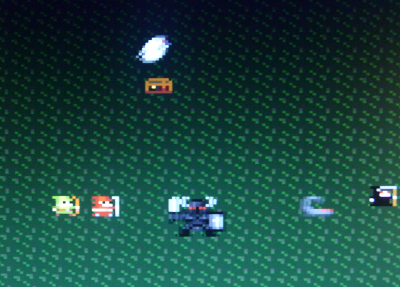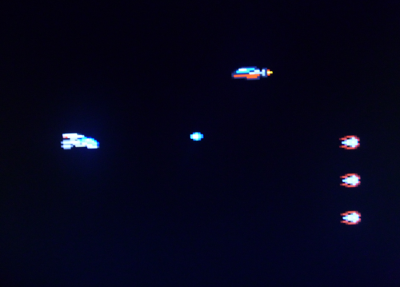A game engine implemented purely in hardware using the VHDL language
(C) Ricardo Jasinski, 2013
-
Overview
-
Technical Details
-
Creating a Game with VAGE
-
Q&A
-
Overview ===========
VAGE (VHDL "Advanced" Game Engine) is a series of hardware modules that help creating simple games in the VHDL language.
- VGA output with 640x480 resolution
- Supports an unlimited number of hardware sprites (8x8 pixels)
- Supported hardware platforms:
- Altera DE2 (35)
There are no planned future releases for this project. However, there are still some things I'd like to add and maybe they will see the light of day. Please drop me a line if you see use for some of these features and maybe we can work on something together.
- Animated sprites
- Support for world maps
- Scrolling background
- Text output
I'd like to add three game demos to be used as templates for new games:
- A space shooter demo
- A bouncing ball ("Arkanoid") demo
- An adventure game demo (this one is currently completed)
This code comes with absolutely no guarantees. This code is public domain and you can do with it whatever you like.
- Technical Details ====================
VAGE provides a sprite engine that takes care of drawing sprites on the screen and checking for collisions. All sprites have a fixed 8x8 size and are defined in terms of paletted colors using the system fixed palette.
Bitmaps for the sprites can be generated using the sprite-gen tool in the scripts folder. This script takes in PNG pictures and selects the best color for each pixel considering the system fixed palette. The output is printed on screen as a VHDL code snippet.
VAGE provides a video engine that generates VGA signals (640x480 @60FPS). It uses a fixed palette with 64 colors (color 0 is transparent), out of 2^24 possible colors. To save resources, a scaling factor may be used. By default, a default value of 2 is used, meaning that the game screen has 320x240 pixels.
The VHDL source code is split into two folders: "engine" and "game/game_name". Code in the "engine" folder should not be changed. Code in the "game" folder must be changed to create the intended game behavior.
- Creating a Game with VAGE ============================
The /hdl/implementation/game folder contains two game demos that can be adapted to created your own game. The best course of action is to choose the demo that is most similar to your original game, and delete the other directories in the game folder. Remember, in theory you shouldn't have to touch anything in the /hdl/implementation/engine folder.
-
Q&A ======
-
If it is so simple, why call it "Advanced"?
Honestly, I just needed a vowel to form an acronym. And maybe someday the project will grow beyond the basic level.

